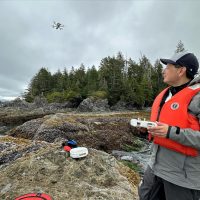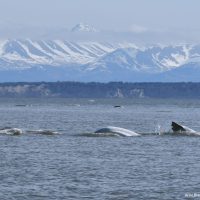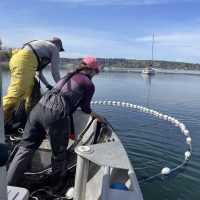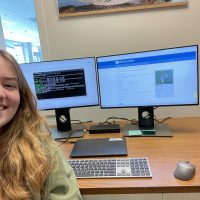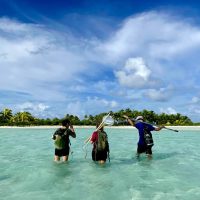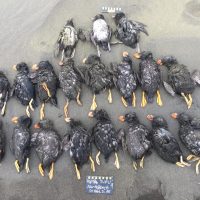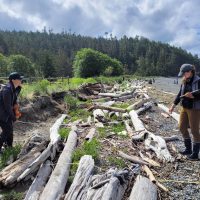Filter Results
Predator-prey relationships in Alaska fisheries management
In the world of fisheries management systems, many do not account for predator-prey interactions that scientists know can have big impacts on the dynamics and available biomass of commercially targeted species.
For his dissertation work as part of the Gulf Of Alaska Climate Integrated Modeling Project (GOA-CLIM), Grant Adams from the Punt Lab at SAFS, has been developing multi-species population dynamics models for the Gulf of Alaska.
Enhancing diversity, conducting drone research: welcome to Corey Garza
Welcoming the newest SAFS Professor and Associate Dean for Diversity, Equity and Inclusion for the College of the Environment, we spoke with Corey Garza. He shares his plans to enhance College diversity, what he’s most excited about by joining SAFS, and insight into his world of research using drones.
What plans do you have for Diversity, Equity and Inclusion (DEI) as Associate Dean?
Cataloging the canaries of the sea: studying vocal behavior, kinship and microbial transfer in Cook Inlet beluga whales
Known as the canaries of the sea for their highly vocal nature, beluga whales are found across the Arctic and sub-Arctic. There are 21 beluga populations worldwide, with five populations found in Alaska. Of these, the Cook Inlet beluga population is the most endangered, with current estimates hovering around the 300 mark. A highly diverged population, the Cook Inlet belugas are geographically and genetically isolated, remaining in Cook Inlet year-round.
Read more“Someday I’ll fly away”: monitoring hatchling to fledgling timescales on Protection Island
Nesting season on Protection Island is a busy time for SAFS Masters student, Liam Pendleton. Home to tens of thousands of pigeon guillemots and rhinoceros auklets, Liam travels to Protection Island in the Strait of Juan de Fuca every week from May to September to conduct research and monitoring of these seabirds.
Working in the Quantitative Conservation Lab, led by Sarah Converse, Liam is studying the link between breeding success, and marine environmental conditions.
Ecosystem modeling of the Gulf of Alaska for fisheries management
In a post-doc focused on modeling climate change effects in the Gulf of Alaska (GOA), Alberto Rovellini is part of the Punt Lab at SAFS. Beginning in 2020, Alberto’s work is on this area of Alaska which is facing big implications as a result of climate change, from negative economic implications for important fisheries to adverse ecological impacts on plankton, fish, mammals, and seabirds.
Read moreNear or far: how is fish abundance affected by shoreline armoring?
Conducting fieldwork as part of a project funded by Washington Sea Grant, Emily Bishop, a masters student in the Marine Conservation and Ecology Group at SAFS, is exploring the effects of shoreline armoring on nearshore fish abundance.
Shoreline armoring is the term for structures that landowners install on their beaches to prevent erosion and preserve property extent. These structures change the physical characteristics of the beach, potentially making the habitat lower quality for fish that use shallow water to avoid predators, or to feed on terrestrial insects.
Mutation rate and mentorship: undergrad summer research with dolphins
Spending the summer working on a mutation rate project with SAFS Professor Amy Van Cise, Sophie Garrote is using bioinformatics to delve into different dolphin species.
Part of a mentorship program through UW LSAMP which focuses on enhancing minority participation in STEM, Sophie has been picking up valuable skills such as programming, knowledge of cetacean species, and getting hands-on experience with research.
Birds, beaches and boat rides: conducting research in Tetiaroa
Almost 5,000 miles away from the University of Washington lies Tetiaroa, an atoll in French Polynesia surrounded by a ring of coral reefs.
A team of UW scientists have visted Tetiaroa each year since 2018 to study seabird populations, which play a vital role in marine environments and the islands that lie within them. A variety of factors negatively impact Tetiaroa’s seabird population, including invasive species and climate change.
Marine heat waves caused mass seabird die-offs, beach surveys show
New research led by the University of Washington uses data collected by coastal residents along beaches from central California to Alaska to understand how seabirds have fared in recent decades. The paper, published July 6 in the journal Marine Ecology Progress Series, shows that persistent marine heat waves lead to massive seabird die-offs months later.
Read moreShoreline restoration: community science to monitor effectiveness
Jason Toft from the UW Wetland Ecosystem Team has been monitoring shoreline armor restoration in Puget Sound for over a decade at sites where artificial armor on beaches has been removed to facilitate the restoration of intertidal areas.
Shoreline armor, also known as seawalls and bulkheads, occurs on over 25% of Puget Sound’s shorelines and was historically installed along homes and infrastructure to address erosion risk.

